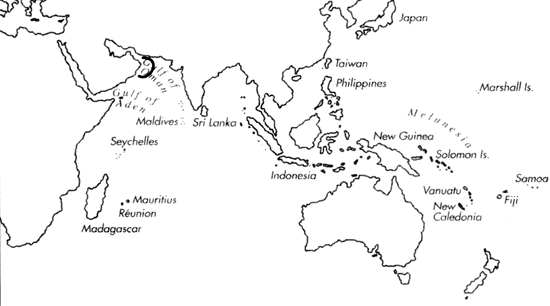Range: Muscat to Al Masirah, Oman.
Description: Moderately small to medium-sized, usually moderately solid. Last whorl ventricosely conical to broadly and ventricosely conical, sometimes broadly ovate; outline convex, less so to straight toward base; left side constricted at base or sigmoid. Shoulder rounded to angulate. Spire of low to moderate height, outline concave to almost straight or slightly sigmoid. Larval shell of about 2 whorls, maximum diameter 1-1.1 mm. Teleoconch sutural ramps flat, with 3 increasing to 5-7 spiral grooves. Last whorl with a few usually weak spiral ribs at base.
| Shell Morphometry | ||
|---|---|---|
| L | 25-55 mm | |
| RW | 0.10-0.32 g/mm | |
| RD | 0.65-0.73 | |
| PMD | 0.70-0.83 | |
| RSH | 0.10-0.20 | |
Ground colour white to light greyish blue. Last whorl usually with brown, olive, orange, or blackish brown flecks, variable in shape and arrangement and often fusing into 3 spiral bands, at centre, below shoulder and at base, and with axial streaks or blotches. Pattern varying from scattered flecks to solid bands. Spiral rows of variably alternating brown and white to light grey dots and dashes generally extending from base to shoulder; rows without light markings intergrade with rows containing only a few dark dots and consisting mainly of light dashes. Base, siphonal fasciole and columella light to dark brown. Apex white to orange. Postnuclear sutural ramps with brown to blackish brown radial streaks and blotches, usually faded in early whorls. Aperture light to dark violet.
Periostracum yellowish olive, rather thin, variably translucent, with tufted spiral ridges on last whorl and spire; tufts usually longer at shoulder edge.
Habitat and Habits: Shallow water; on coral reef.
Discussion: C. ardisiaceus resembles C. anemone, C. tinianus and C. papilliferus. For comparison with C. anemone and C. papilliferus, see the Discussions of those species. C. tinianus (see Vol. II) differs in a narrower last whorl (RD about 0.53-0.66) that is ventricosely conical to conoid-cylindrical rather than to ovate (PMD about 0.76-0.84); the spiral sculpture on its late sutural ramps is finer and weak to obsolete. C. tinianus has a yellow to orange-red or a black animal that is heavily dotted with white. The taxonomic status of C. ardisiaceus was disputed until Coomans et al. (1981) designated a neotype (Pl. 59, Fig. 2) satisfactorily corresponding with Kiener's original figure (Pl. 59, Fig. 1). We agree with these authors in applying the name to a Conus species endemic to Oman.

C. ardisiaceus range map
This section contains verbatim reproductions of the accounts of 316 species of Conus from the Indo-Pacific region, from Manual of the Living Conidae, by Röckel, Korn and Kohn (1995). They are reproduced with the kind permission of the present publisher, Conchbooks.
All plates and figures referred to in the text are also in Röckel, Korn & Kohn, 1995. Manual of the Living Conidae Vol. 1: Indo-Pacific Region.
The range maps have been modified so that each species account has it own map, rather than one map that showed the ranges of several species in the original work. This was necessary because each species account is on a separate page on the website and not confined to the order of accounts in the book.